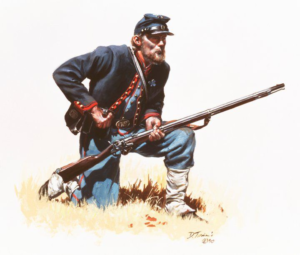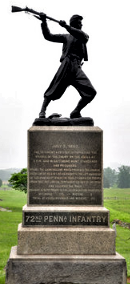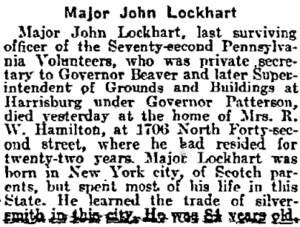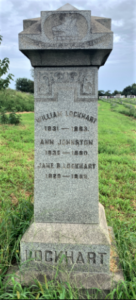Title: Army Major, Civil War; silversmith
Birthdate: January 14, 1833
Death Date: February 26, 1917
Plot Location: Section 201, Lot

John’s parents, John and Joan, were married in Edinburgh, Scotland in 1830. Their first son, William, was born the following year, and John arrived two years later. The family emigrated from Greenock, Scotland in June, 1834, so little Johnny might not have taken his first steps until he was stepping on American soil.
The third child, Ann, was born in New York in 1836, which is where the senior John died in 1839. At some point the family moved to Philadelphia where both boys became apprentice silversmiths. It doesn’t appear that William had any interest in serving his country, but John did.
He joined Company C of the 72nd Pennsylvania Volunteer Infantry in 1861 as a First Lieutenant,  rising to Captain in 1862 and Major in 1864. Many of the men were recruited from the fire stations of the city and wore a distinctive dark and light blue uniform with red trim, similar to this illustration.
rising to Captain in 1862 and Major in 1864. Many of the men were recruited from the fire stations of the city and wore a distinctive dark and light blue uniform with red trim, similar to this illustration.
(Two young men from the Spring Garden fire station joined Company A of the 72nd but died at Antietam and were buried here at Mount Moriah. Their Notable story is here.)
Along with the 69th, 71st, and 106th, the 72nd formed the famed Philadelphia Brigade which helped defend against Pickett’s Charge in the Battle of Gettysburg. That’s where Captain Lockhart was wounded but he was able to return to duty, serving until the 72nd was discharged in August of 1864. The 72nd is remembered at Gettysburg with this monument.
John’s most notable moment may actually have been 24 years later at the anniversary of Pickett’s Charge in 1887. At the reunion of the Philadelphia Brigade Association he made a motion to invite members of the Pickett’s Division Association (Confederate veterans) to be their guests at a “Reunion of Foes.” It was a radical idea and not without controversy, but it set the stage for reconciliation among the two groups.
In civilian life, John returned to William’s trade of silversmithing, married Mary Lamplugh in 1871, and became involved in Republican party politics. The 1880 census lists his occupation as clerk to the state’s Secretary of Internal Affairs. (A 31st Infantry veteran named William McCandless was Secretary of Internal Affairs from 1875-79 and is buried at Mount Moriah. Read his Notable story here.)
John left the silversmith business for good in the mid 1880s after a series of family tragedies. Ann died in 1880, William in 1883, and Mary in 1884, leaving him with no children and no relatives except William’s wife, Jane, who died in 1899.
John lived in a boarding house the rest of his life and was the secretary to Governor James Beaver  from 1887-1891. He stayed in government administration when Democratic Governor Robert Pattison was in office from 1891-1895. This obituary gives details but mistakenly says he was born in New York.
from 1887-1891. He stayed in government administration when Democratic Governor Robert Pattison was in office from 1891-1895. This obituary gives details but mistakenly says he was born in New York.
Mary’s burial was in her family’s plot in Section 31, Lot 16. This Lockhart  monument commemorates William, Ann and Jane on the front, with John’s name on the side. On the cap is the inscription, “Semper paratus pugnare propatria,” or in English, “Always ready to fight for my country,” reflecting John’s sense of duty, both on the battlefield and at the state house.
monument commemorates William, Ann and Jane on the front, with John’s name on the side. On the cap is the inscription, “Semper paratus pugnare propatria,” or in English, “Always ready to fight for my country,” reflecting John’s sense of duty, both on the battlefield and at the state house.

Support the Friends of Mount Moriah
Help us in our mission to restore and maintain the beautiful Mount Moriah Cemetery by donating to our cause or volunteering at one of our clean-up events.

